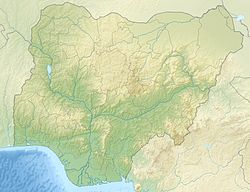| Kwa Ilbo River | |
|---|---|
| Location | |
| Country | Nigeria |
| State | Abia State |
| Physical characteristics | |
| Mouth | |
• coordinates | 4°32′27″N7°59′19″E / 4.54083°N 7.98861°E |
| Basin features | |
| Progression | Atlantic Ocean |
The Kwa Ibo River (also Quaibo River) is a river that rises near Umuahia in Abia State, Nigeria, [1] and flows in a southeastern direction through Akwa Ibom State to the Atlantic Ocean. [2] [3]
[4] stern side of the Kwa Ibo River about 3 kilometres (2 mi) from the river mouth, is one of the largest fishing settlements on the Nigerian coast. [5] [6] The Kwa Ibo River discharges 92,900 tonnes of plastic under the lower mass input category and 20,800 tonnes at the upper mass input category.
